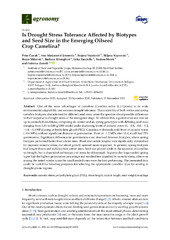Приказ основних података о документу
Is Drought Stress Tolerance Affected by Biotypes and Seed Size in the Emerging Oilseed Crop Camelina?
| dc.creator | Čanak, Petar | |
| dc.creator | Marjanović-Jeromela, Ana | |
| dc.creator | Vujošević, Bojana | |
| dc.creator | Kiprovski, Biljana | |
| dc.creator | Mitrović, Bojan | |
| dc.creator | Alberghini, Barbara | |
| dc.creator | Facciolla, Erika | |
| dc.creator | Monti, Andrea | |
| dc.creator | Zanetti, Federica | |
| dc.date.accessioned | 2021-04-26T19:53:24Z | |
| dc.date.available | 2021-04-26T19:53:24Z | |
| dc.date.issued | 2020 | |
| dc.identifier.issn | 2073-4395 | |
| dc.identifier.uri | http://fiver.ifvcns.rs/handle/123456789/2006 | |
| dc.description.abstract | One of the main advantages of camelina (Camelina sativa (L.) Crantz) is its wide environmental adaptability and extreme drought tolerance. The availability of both winter and spring camelina biotypes, characterized by different seed sizes, raises the question about possible differences in their response to drought stress at the emergence stage. To address this, a germination test was set up in controlled conditions, comparing six winter and six spring genotypes with differing seed sizes (ranging from 1.83 to 0.88 g/1000-seeds) under increasing levels of osmotic stress (0, -0.4, -0.8, -1.2, -1.4, -1.6 MPa) using polyethylene glycol (PEG). Camelina withstands mild level of osmotic stress (-0.4 MPa) without significant decrease in germination. Even at -1.2 MPa after 10 d, it still had 75% germination. Significant differences in germination were observed between biotypes, where spring biotypes performed better than winter ones. Shoot and radicle lengths were significantly diminished by imposed osmotic stress, but shoot growth seemed more impacted. In general, spring biotypes had longer shoots and radicles than winter ones. Seed size played a role in the response of camelina to drought, but it depended on biotype and stress level imposed. In particular large seeded spring types had the highest germination percentage and resulted less impaired by osmotic stress, otherwise among the tested winter types the small seeded ones were the best performing. The presented data could be useful for breeding purposes for selecting the appropriate camelina type for sowing in drought-prone regions. | en |
| dc.publisher | Basel : MDPI | |
| dc.relation | info:eu-repo/grantAgreement/MESTD/inst-2020/200032/RS// | |
| dc.rights | openAccess | |
| dc.source | Agronomy-Basel | |
| dc.subject | osmotic stress | en |
| dc.subject | polyethylene glycol (PEG) | en |
| dc.subject | shoot length | en |
| dc.subject | radicle length | en |
| dc.subject | seed weight | en |
| dc.subject | mucilage | en |
| dc.title | Is Drought Stress Tolerance Affected by Biotypes and Seed Size in the Emerging Oilseed Crop Camelina? | en |
| dc.type | article | |
| dc.rights.license | ARR | |
| dc.citation.issue | 12 | |
| dc.citation.other | 10(12) | |
| dc.citation.rank | M21 | |
| dc.citation.volume | 10 | |
| dc.identifier.doi | 10.3390/agronomy10121856 | |
| dc.identifier.fulltext | http://fiver.ifvcns.rs/bitstream/id/934/2003.pdf | |
| dc.identifier.scopus | 2-s2.0-85102388085 | |
| dc.identifier.wos | 000602217700001 | |
| dc.type.version | publishedVersion |


